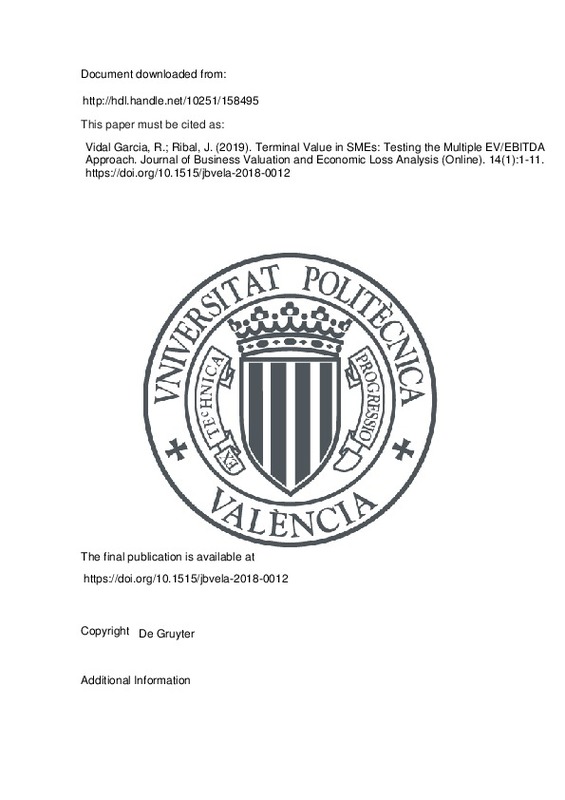JavaScript is disabled for your browser. Some features of this site may not work without it.
Buscar en RiuNet
Listar
Mi cuenta
Estadísticas
Ayuda RiuNet
Admin. UPV
Terminal Value in SMEs: Testing the Multiple EV/EBITDA Approach
Mostrar el registro sencillo del ítem
Ficheros en el ítem
| dc.contributor.author | Vidal Garcia, Raül
|
es_ES |
| dc.contributor.author | Ribal, Javier
|
es_ES |
| dc.date.accessioned | 2021-01-09T04:31:46Z | |
| dc.date.available | 2021-01-09T04:31:46Z | |
| dc.date.issued | 2019-03-26 | es_ES |
| dc.identifier.uri | http://hdl.handle.net/10251/158495 | |
| dc.description.abstract | [EN] This study focuses on answering whether EV/EBITDA multiple of public companies in the food industry can be useful to obtain the Terminal Value (TV) in the valuation of unlisted small and medium-sized food companies. A case study into Spanish unlisted agribusinesses is designed for several samples and accounting years from 2010 to 2013. By means of a discounted cash flow (DCF) model combined with bootstrap techniques, the TV/EBITDA empirical distribution of the unlisted multiples is obtained for two different scenarios of free cash flow (FCF) growth, and then compared with the EV/EBITDA of the listed companies in the same industry. The results show that the stock market EV/EBITDA multiple may be used to determine the TV in the valuation process of unlisted small and medium-sized food companies that consistently obtain positive cash flows. | es_ES |
| dc.language | Inglés | es_ES |
| dc.publisher | De Gruyter | es_ES |
| dc.relation.ispartof | Journal of Business Valuation and Economic Loss Analysis (Online) | es_ES |
| dc.rights | Reserva de todos los derechos | es_ES |
| dc.subject | Terminal value | es_ES |
| dc.subject | Valuation multiples | es_ES |
| dc.subject | SMEs | es_ES |
| dc.subject | Food companies | es_ES |
| dc.subject | EV/EBITDA | es_ES |
| dc.subject | Bootstrap | es_ES |
| dc.subject.classification | ECONOMIA, SOCIOLOGIA Y POLITICA AGRARIA | es_ES |
| dc.title | Terminal Value in SMEs: Testing the Multiple EV/EBITDA Approach | es_ES |
| dc.type | Artículo | es_ES |
| dc.identifier.doi | 10.1515/jbvela-2018-0012 | es_ES |
| dc.rights.accessRights | Abierto | es_ES |
| dc.contributor.affiliation | Universitat Politècnica de València. Departamento de Economía y Ciencias Sociales - Departament d'Economia i Ciències Socials | es_ES |
| dc.description.bibliographicCitation | Vidal Garcia, R.; Ribal, J. (2019). Terminal Value in SMEs: Testing the Multiple EV/EBITDA Approach. Journal of Business Valuation and Economic Loss Analysis (Online). 14(1):1-11. https://doi.org/10.1515/jbvela-2018-0012 | es_ES |
| dc.description.accrualMethod | S | es_ES |
| dc.relation.publisherversion | https://doi.org/10.1515/jbvela-2018-0012 | es_ES |
| dc.description.upvformatpinicio | 1 | es_ES |
| dc.description.upvformatpfin | 11 | es_ES |
| dc.type.version | info:eu-repo/semantics/publishedVersion | es_ES |
| dc.description.volume | 14 | es_ES |
| dc.description.issue | 1 | es_ES |
| dc.identifier.eissn | 1932-9156 | es_ES |
| dc.relation.pasarela | S\381524 | es_ES |
| dc.description.references | Petersen, C., Plenborg, T., & Scholer, F. (2006). Issues in Valuation of Privately Held Firms. The Journal of Private Equity, 10(1), 33-48. doi:10.3905/jpe.2006.667557 | es_ES |
| dc.description.references | Breuer, W., Fuchs, D., & Mark, K. (2012). Estimating cost of capital in firm valuations with arithmetic or geometric mean – or better use the Cooper estimator? The European Journal of Finance, 20(6), 568-594. doi:10.1080/1351847x.2012.733717 | es_ES |
| dc.description.references | Vydržel, K., & Soukupová, V. (2012). Empirical Examination of Valuation Methods Used in Private Equity Practice in the Czech Republic. The Journal of Private Equity, 16(1), 83-99. doi:10.3905/jpe.2012.16.1.083 | es_ES |
| dc.description.references | Imam, S., Barker, R., & Clubb, C. (2008). The Use of Valuation Models by UK Investment Analysts. European Accounting Review, 17(3), 503-535. doi:10.1080/09638180802016650 | es_ES |
| dc.description.references | Gavious, I., & Parmet, Y. (2010). Do private firm valuations contain incremental information content over routine analyst valuations? Research in International Business and Finance, 24(2), 223-234. doi:10.1016/j.ribaf.2009.12.003 | es_ES |
| dc.description.references | Cañadas, J. A., & Rojo Ramirez, A. A. (2011). The Discount Rate in Valuing Privately Held Companies. Business Valuation Review, 30(2), 70-81. doi:10.5791/0882-2875-30.2.70 | es_ES |
| dc.description.references | Eberhart, A. C. (2004). Equity Valuation Using Multiples. The Journal of Investing, 13(2), 48-54. doi:10.3905/joi.2004.412306 | es_ES |
| dc.description.references | Jennergren, L. P. (2008). Continuing value in firm valuation by the discounted cash flow model. European Journal of Operational Research, 185(3), 1548-1563. doi:10.1016/j.ejor.2006.08.012 | es_ES |
| dc.description.references | Efron, B. (1979). Bootstrap Methods: Another Look at the Jackknife. The Annals of Statistics, 7(1), 1-26. doi:10.1214/aos/1176344552 | es_ES |
| dc.description.references | Liu, J., Nissim, D., & Thomas, J. (2002). Equity Valuation Using Multiples. Journal of Accounting Research, 40(1), 135-172. doi:10.1111/1475-679x.00042 | es_ES |
| dc.description.references | Gordon, M. J., & Shapiro, E. (1956). Capital Equipment Analysis: The Required Rate of Profit. Management Science, 3(1), 102-110. doi:10.1287/mnsc.3.1.102 | es_ES |
| dc.description.references | Ramírez, A. A. R., & de Lema, D. G. P. (2006). La Valoración de Empresas en España: un estudio empírico. Spanish Journal of Finance and Accounting / Revista Española de Financiación y Contabilidad, 35(132), 913-934. doi:10.1080/02102412.2006.10779611 | es_ES |
| dc.description.references | Plenborg, T., & Pimentel, R. C. (2016). Best Practices in Applying Multiples for Valuation Purposes. The Journal of Private Equity, 19(3), 55-64. doi:10.3905/jpe.2016.19.3.055 | es_ES |
| dc.description.references | Hamada, R. S. (1972). THE EFFECT OF THE FIRM’S CAPITAL STRUCTURE ON THE SYSTEMATIC RISK OF COMMON STOCKS. The Journal of Finance, 27(2), 435-452. doi:10.1111/j.1540-6261.1972.tb00971.x | es_ES |







![[Cerrado]](/themes/UPV/images/candado.png)

